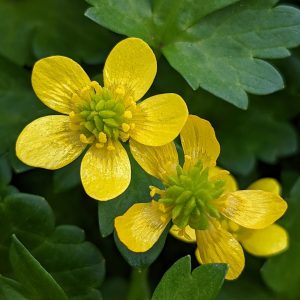Sharp Buttercup (Ranunculus muricatus), a southern European mainstay of damp verges and river muds.
Included on the laundry list of common weeds proclaimed by the Commonwealth in 1909 under its new Quarantine Act, Sharp Buttercup like most of the plants on that list had already conclusively established here long before the barn door was performatively closed by federal legislation.
Collected at Melbourne by von Mueller in 1853, Sharp Buttercup presumably arrived as a contaminant amongst the earliest imports of lawn and pasture seed. Unpalatable, tolerant of mowing and happy to persist in feet wet conditions, it would soon be widespread on moist ground across the colony. By 1909 the species was described by Ewart and Tovey as one of the two buttercups which were serious pests in Victoria, ‘intensely acrid [and] useless for grazing,’ but following their advice apparently controllable in wet pastures by planting the dominating Birds Foot Trefoil (Lotus corniculatus).
At SA, while the first formal collection appears only to have been made in 1892, the species was reportedly common around parts of Adelaide by 1879. Initially a weed of domestic lawns and other cultivated places, the colonial presence of this species was often presumably wholly unremarkable. The same pattern is on display in NSW, where a correspondent at Kiama submitted a sample to Australian Town & Country for identification in 1900, but the first (digitised) botanical collection dates only to 1924.
The photographs here show the species in its typical range of metropolitan ecotones, from mown nature strip to less frequently managed verges to river muds dividing the minor channels of the Merri Creek above the gorge at Galada Tambore.
View Original Post on Instagram
Search for information about Ranunculus muricatus in the Flora of Victoria
View information and occurrences of Ranunculus muricatus on the Atlas of Living Australia










